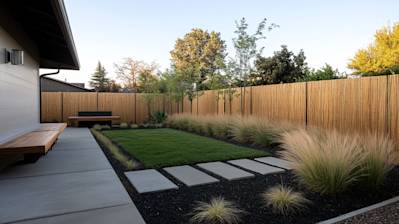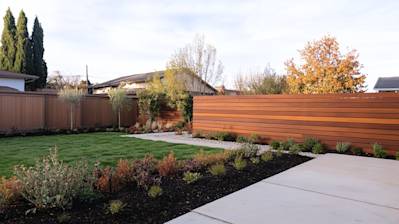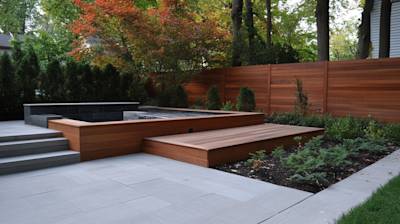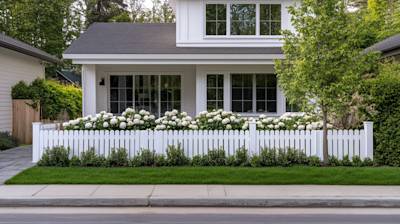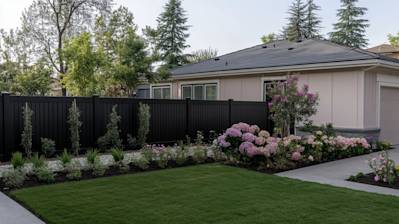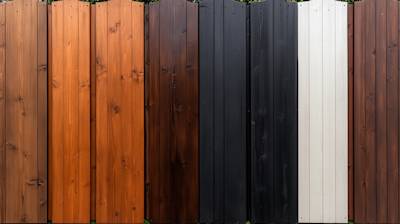Are you considering enhancing the aesthetic appeal and durability of your outdoor space? Then fence staining might need your immediate attention. In this comprehensive guide, we will explore everything you need to know about fence staining.
Understanding The Basics of Fence Staining
Fence staining involves applying a colorant to wooden fences to boost their appeal, improve their lifespan while also providing protection from environmental elements like rain and sunlight.
Why Should You Opt For Fence Staining?
- It increases the fence's durability by preventing rot caused by exposure to water
- It protects the fence from harmful UV rays, minimizing color fading
- It improves the exterior aesthetics by enhancing the natural wood grain
- It repels insects and other pests that might harm the fence
Considerations Before Fence Staining
Before you start, it's essential to understand a few crucial elements that would impact the effectiveness of your fence staining project:
Type of Wood
The type of wood your fence is made from impacts the kind of stain you should use. Woods like cedar and redwood absorb stain well, whereas treated lumber might require specific types of stain.
Age of the Fence
New fences should ideally be stained a few weeks after installation to ensure full absorption of the stain. In contrast, old fences may need a clean and repair before staining.
Climate
Because stain absorption depends on temperature and humidity, it is best to stain when temperatures range from 50-90 degrees Fahrenheit, and humidity is moderate.
Workshop Must-Haves: Essential Fence Staining Tools
- Stain or Sealant: Depending on your fence type and personal preference, you can opt for a semi-transparent or solid stain.
- Staining Brush: A quality brush yields a smooth and even application of stain.
- Paint Sprayer: This tool works well for large fences.
- Roller: An ideal tool for applying stain on flat surfaces.
- Drop Cloths: Use these to protect surrounding areas from stain drips and spills.
Comprehensive Step-by-Step Guide to Fence Staining
After assembling your tools and considering your unique fencing situation, you can start the staining process.
Preparation
- Clean the Fence: Removing debris, dirt, and old paint will allow the stain to adhere better.
- Repair Any Damages: Fix any broken or rotting parts before staining.
- Cover Surrounding Areas: Use tarps or drop cloths to protect plants and other aspects from the stain.
Staining
- Apply the Stain: Use a brush, roller, or sprayer for an even application. Always follow the directions on your stain’s packaging for best results.
- Keep a Wet Edge: To prevent overlap marks, always maintain a 'wet edge'.
- Let it Dry: Allow the stain to fully dry before applying further coats or touching the fence.
Maintaining Your Newly Stained Fence
Fence staining requires consistent maintenance to retain its look and ensure extended lifespan. The maintenance plan centers on:
- Regularly cleaning the fence to avoid build-up of dirt and algae
- Checking for damages so timely repairs can be performed
- Reapplying the stain every few years, based on the fence's exposure to environmental elements
Frequently Asked Questions about Fence Staining
Which Fence Staining Product Should I Use?
Choosing the right fence staining product depends mainly on your specific needs and preferences. Oil-based stains tend to be more durable and provide deeper penetration for better protection. Water-based stains are easier to clean up, have less odor, and are eco-friendly.
How Often Should I Stain My Fence?
Typically, fences need to be restained every 2-3 years. The specific time frame, however, depends on the type of stain used, the vocational climate, and the state of the wood used for the fence. For instance, harsh weather conditions might necessitate more frequent staining.
What is the Best Weather for Fence Staining?
It's best to stain a fence when the weather is dry and mild. Temperatures between 50-90 degrees Fahrenheit with low humidity offer the perfect conditions for staining. Always check your local weather forecast before starting your project.
How to Prepare my Fence for Staining?
Prior preparation is essential for successful fence staining. You need to clean the fence thoroughly and let it dry. This process may involve power washing or scrubbing the fence with a brush to remove grime and peeling paint.
What's the Right Way to Apply Fence Stain?
Start by stirring the stain well and using a brush, roller, or sprayer to apply the stain, following the wood's grain direction. Work on one section at a time and apply an even coat. Once dry, inspect the fence for any missed spots and apply a second coat if necessary.
How Long Does Fence Stain Need to Dry?
Fence stain generally takes 24 to 48 hours to dry fully, but this can vary based on the product used, application method, and weather conditions. It's essential to ensure the stain is completely dry before you touch the fence.
How Much Does Fence Staining Cost?
The cost of fence staining depends on multiple factors, including the size of the fence, condition of the wood, type of stain used, and whether you're doing it yourself or hiring a professional. It's best to get a quote to get an accurate estimate.
What's the Difference between Fence Staining and Painting?
Fence staining and painting keep your fence looking fresh and new but are different. Staining penetrates the wood surface, offering protection without hiding the wood grain while painting forms a protective film on top, largely concealing the wood grain.
Can I Stain Over an Existing Finish?
Yes, it's possible to stain over an existing finish. However, the new staining would be more productive if the old finish is removed or adequately roughed up. Always clean and prepare the fence adequately before re-staining.
Pros of Fence Staining
Aesthetic Enhancement
Amplifying Curb Appeal
One of the biggest pros to fence staining is the significant improvement it makes to the aesthetics of your house. When applied properly, it provides your fence with a fresh, polished look that can enhance your property's overall curb appeal. The sheer variety of stains available, from vibrant hues to more subdued tones, allows homeowners to select the perfect color that best compliments their property.
Conceals Imperfections
Fence staining enables homeowners to effectively conceal any minor imperfections that may be present on their wooden fences. This could include scratches, discolorations, or marks that generally degrade the appearance of an otherwise perfectly sound fence.
Durability Enhancement
Prolongs the Fence Life
Staining a fence helps to extend its lifespan considerably. It provides a protective layer between the fence and various destructive elements such as rain, sunlight, and insects - all of which could potentially harm the wood over time.
Prevents Rot
Some stains have specific chemical properties designed to prevent the onset of rot in wooden fences. This is particularly important as rot is one of the primary reasons behind fence degradation. It begins as a mild, almost unnoticeable lifeless patch and eventually eats away and weakens the whole structure of the fence.
Resisting Fading
Stains are designed to resist fading even after being exposed to the harsh elements for Continued periods. This ensures your fence maintains its original appeal for a long time, with minimal upkeep.
Financial Consideration
Cost-Effective
Compared to other methods of preserving and beautifying a fence, stain is relatively cost-effective. As opposed to replacing a whole fence because it's weather-worn, a bottle of stain and a little effort can bring it back to life at a fraction of the cost.
Increases Property Value
With the aesthetics and durability that a well-stained fence provides, it can potentially increase the value of your property. This could be of significant advantage should you ever consider selling your home.
Cons of Fence Staining
Application Process
Time-Consuming
One major drawback to fence staining is that it could be a time-consuming process. The actual application of the stain may not take very long but preparing the fence for staining can take significant time. Scrubbing and sanding the fence to ensure a smooth and clean surface is vital and it can indeed be a labor-intensive task.
Requires Skills and Knowledge
While some homeowners may see DIY fence staining as a fun and cost-saving experience, it's not always straightforward. It requires careful application and the right technique to ensure an even and smooth finish. Inaccurate application might result in blotchy or unsightly patches.
Health and Safety Considerations
Hazardous Chemicals
Some stains contain Volatile Organic Compounds (VOCs) that are harmful both to humans and animals. Exposure to these compounds can cause headaches, dizziness, visual disorders, and memory impairment among other health effects.
Allergenic
Some stain products can also be allergenic. Individuals with sensitive skin might experience skin irritation, itching, or even rashes upon contact.
Maintenance Aspect
Needs Regular Application
Despite the durability that stain provides, it's not a once-and-done solution. Stains will fade over time, especially in areas with harsh weather conditions, necessitating reapplication every few years.
Difficulty in Changing Colors
Another downside is that once you stain your fence a certain color, it can be tough to change that color. The stain penetrates the wood, so if you decide you want a different color, you will likely need to sand the fence down before applying the new color.
Myths and Misconceptions about Fence Staining
Fence staining can seem like a straightforward task, but if you've ever embarked on a do-it-yourself fence staining project, you know it isn't always as simple as it looks. Additionally, there's a fair share of misconceptions about the whole process and its benefits. This section aims to bust those myths wide open!
Myth 1: Any Stain Will Do
The Claim
Many people believe that you can use any stain and the effects will be the same. They think that a stain is a stain, and as long as it is applied correctly, there won't be much difference in the end result.
The Truth
In reality, there is a vast range of stains to choose from, each formulated to provide different benefits and finishes. Some stains are designed to preserve the natural color of the wood, others darken or tint the wood a particular color. Additionally, some stains ward off particular types of damage such as UV, water, or even pest damage. So, your choice of stain does matter a lot depending on your needs and desired aesthetic result.
Myth 2: Staining is Only About Aesthetics
The Claim
Many DIY enthusiasts believe that staining a fence is purely about giving it a certain color or look.
The Truth
While staining can indeed change the appearance of your fence, its primary function is to protect the fence from environmental damage. Wood is a vulnerable material, and without protection, it can quickly degrade under the effects of moisture, UV rays, and insects. A good stain will serve to protect your fence from these threats, extending its lifespan significantly.
Myth 3: New Fences Don't Need to be Stained
The Claim
A common misconception is that new fences don't need to be stained. Some people believe that the new wood is strong enough to withstand the environmental stress for the first few years.
The Truth
While it might seem logical to think that new wood is more resistant, the reality is that new fences benefit greatly from staining. It's better to stain a new fence than to wait for signs of weathering. Staining a new fence enhances its resistance to wear and tear right off the bat, preventing premature damage and aging.
Myth 4: One Coat of Stain is Enough
The Claim
One coat of stain is all you need to protect and beautify your fence. People who hold this view think it saves them time and resources.
The Truth
Certain stains may indeed only require one coat, but many will benefit from multiple coats. The coat level depends on the type of stain, the wood, and the level of protection you desire. Applying more than one coat may provide a stronger barrier, better color, and longer-lasting protection. Therefore, it's essential to follow the manufacturer's instructions and to assess the end result after each coat.
Myth 5: The Staining Process is Just Slapping on Some Paint
The Claim
Staining a fence is as easy as just painting on the stain and letting it dry.
The Truth
Contrary to this belief, staining involves several vital steps to ensure longevity and effectiveness. The process often includes cleaning the fence, allowing it to dry, applying the stain, and then letting it cure. Skipping any of these steps or rushing the process might leave you with a poorly protected fence and an uneven, unattractive finish.
Myth 6: Stained Fences Don't Require Maintenance
The Claim
Once your fence is stained, it doesn't need any care or upkeep.
The Truth
Staining does provide a crucial layer of protection, but it doesn't mean your fence is now maintenance-free. Periodic cleaning, inspections for damage, and touch-ups on the stain are important parts of maintaining the longevity and aesthetics of your fence. Stain may need to be reapplied every few years, depending on the climate and the quality of the product used.
Knowledge is essential when it comes to home improvement tasks such as fence staining. Hopefully, by debunking these common myths, you are now equipped with a better sense of what to expect when staining your fence and can avoid these common mistakes. Happy staining!
Summary
So, there you have it! Just remember to properly clean and prep your fence before embarking on the staining process. Fence staining not only improves the overall aesthetic of your yard, it also increases the lifespan of your wooden fence by protecting it against harsh weather conditions, especially when using a quality stain. The best part is, doing the job yourself can save some bucks, while providing a satisfying payoff for your hard work.
That's the gist of it. Fence staining might appear challenging and time-consuming at first, but as you go through the steps, it becomes more straightforward and gratifying. It's an easy way to spruce up your backyard while also investing in the durability of your fence. So, why not grab a brush, pick your favourite colour and feel the joy of watching your old fence spring to life.
To sum it all up, fence staining is more than just making your fence look good. It's about protecting your fence, enhancing the life of the wood, and adding character to your outdoor space. So, even if it seems like a big project, don't forget the satisfaction that comes from seeing a job well done. With a bit of effort, your fence can be a reflection of your style and taste, making your home truly your own.
About Ornamental Solutions
Ornamental Solutions is a beloved institution based in Sacramento, CA, dedicated to enhancing the beauty of spaces with timeless elegance. We combine our passion for creativity with meticulous craftsmanship to provide exceptional ornamental designs that enhance the aesthetics of both residential and commercial spaces. Our team is skilled in creating bespoke architectural elements that harmonize with any design aesthetic. With years of experience under our belt and a drive to continually push the boundaries of imagination and innovation, you can trust Ornamental Solutions to transform the ordinary into the extraordinary. We can't wait to work together to create something truly beautiful.



